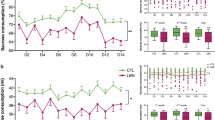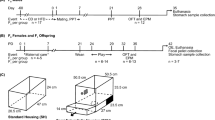Abstract
The early life origins of risk for mood disorders and anxiety are supported by longitudinal studies in humans, particularly those focused on the experience of childhood adversity. Animal models have further supported the association between stress exposure during infancy and neurodevelopmental and physiological processes that shape behavioral indices of depression and anxiety. In rodents, these models have focused on disruption to mother–infant interactions that occur either naturally or through manipulation of the quantity and/or quality of maternal care. Though these models are challenging to implement, they serve as essential tools for establishing or characterizing the neurodevelopmental trajectories that lead to increased risk of psychopathology. In this chapter, we will describe methods that can be used to quantify maternal behavior in rats and mice, with particular emphasis on the use of newly developed video recording and machine learning approaches. We will also describe the premise and protocol for an established methodology to effectively manipulate mother–infant interactions within experimental designs that are exploring neurobiological and behavioral outcomes in offspring. This limited bedding and nesting material (LBN) manipulation is used broadly to study the impact of early life stress in rodents and when combined with high-resolution behavioral quantification approaches can yield novel hypotheses regarding the molecular, cellular, physiological, and behavioral mechanisms that contribute to altered brain function across the life span.
Access this chapter
Tax calculation will be finalised at checkout
Purchases are for personal use only
Similar content being viewed by others
References
Petruccelli K, Davis J, Berman T (2019) Adverse childhood experiences and associated health outcomes: a systematic review and meta-analysis. Child Abuse Negl 97:104127. https://doi.org/10.1016/j.chiabu.2019.104127
Trickett PK, McBride-Chang C (1995) The developmental impact of different forms of child abuse and neglect. Dev Rev 15:311–337. https://doi.org/10.1006/drev.1995.1012
Sánchez MM, Ladd CO, Plotsky PM (2001) Early adverse experience as a developmental risk factor for later psychopathology: evidence from rodent and primate models. Dev Psychopathol 13:419–449
Kundakovic M, Lim S, Gudsnuk K, Champagne FA (2013) Sex-specific and strain-dependent effects of early life adversity on behavioral and epigenetic outcomes. Front Psychiatry 4:78. https://doi.org/10.3389/fpsyt.2013.00078
Franklin TB, Russig H, Weiss IC et al (2010) Epigenetic transmission of the impact of early stress across generations. Biological psychiatry 68:408–415. https://doi.org/10.1016/j.biopsych.2010.05.036
Rice CJ, Sandman CA, Lenjavi MR, Baram TZ (2008) A novel mouse model for acute and long-lasting consequences of early life stress. Endocrinology 149:4892–4900. https://doi.org/10.1210/en.2008-0633
Franks B, Curley JP, Champagne FA (2011) Measuring variations in maternal behavior: relevance for studies of mood and anxiety. In: Gould TD (ed) Mood and anxiety related phenotypes in mice: characterization using behavioral tests, vol II. Humana Press, Totowa, pp 209–224
Molet J, Heins K, Zhuo X et al (2016) Fragmentation and high entropy of neonatal experience predict adolescent emotional outcome. Transl Psychiatry 6:e702–e702. https://doi.org/10.1038/tp.2015.200
Walker C-D, Bath KG, Joels M et al (2017) Chronic early life stress induced by limited bedding and nesting (LBN) material in rodents: critical considerations of methodology, outcomes and translational potential. Stress 20:421–448. https://doi.org/10.1080/10253890.2017.1343296
Lapp HE, Mueller I, Moore CL (2020) Limited bedding and nesting material changes indices of cellular metabolism and behavioral thermal regulation in Long-Evans rats during the first two weeks of life. Physiol Behav 222:112957. https://doi.org/10.1016/j.physbeh.2020.112957
Bath K, Manzano-Nieves G, Goodwill H (2016) Early life stress accelerates behavioral and neural maturation of the hippocampus in male mice. Horm Behav 82:64–71. https://doi.org/10.1016/j.yhbeh.2016.04.010
Molet J, Maras PM, Avishai-Eliner S, Baram TZ (2014) Naturalistic rodent models of chronic early-life stress. Dev Psychobiol 56:1675–1688. https://doi.org/10.1002/dev.21230
McLaughlin RJ, Verlezza S, Gray JM et al (2016) Inhibition of anandamide hydrolysis dampens the neuroendocrine response to stress in neonatal rats subjected to suboptimal rearing conditions. Stress 19:114–124. https://doi.org/10.3109/10253890.2015.1117448
Moussaoui N, Jacobs JP, Larauche M et al (2017) Chronic early-life stress in rat pups alters basal corticosterone, intestinal permeability, and fecal microbiota at weaning: influence of sex. J Neurogastroenterol Motil 23:135–143. https://doi.org/10.5056/jnm16105
Brunson KL, Kramár E, Lin B et al (2005) Mechanisms of late-onset cognitive decline after early-life stress. J Neurosci 25:9328–9338. https://doi.org/10.1523/JNEUROSCI.2281-05.2005
Ivy AS, Rex CS, Chen Y et al (2010) Hippocampal dysfunction and cognitive impairments provoked by chronic early-life stress involve excessive activation of CRH receptors. J Neurosci 30:13005–13015. https://doi.org/10.1523/JNEUROSCI.1784-10.2010
Gunn BG, Cunningham L, Cooper MA et al (2013) Dysfunctional astrocytic and synaptic regulation of hypothalamic glutamatergic transmission in a mouse model of early-life adversity: relevance to neurosteroids and programming of the stress response. J Neurosci 33:19534–19554. https://doi.org/10.1523/JNEUROSCI.1337-13.2013
Raineki C, Moriceau S, Sullivan RM (2010) Develo** a neurobehavioral animal model of infant attachment to an abusive caregiver. Biol Psychiatry 67:1137–1145. https://doi.org/10.1016/j.biopsych.2009.12.019
Wang X-D, Labermaier C, Holsboer F et al (2012) Early-life stress-induced anxiety-related behavior in adult mice partially requires forebrain corticotropin-releasing hormone receptor 1. Eur J Neurosci 36:2360–2367. https://doi.org/10.1111/j.1460-9568.2012.08148.x
Bath KG, Nitenson AS, Lichtman E et al (2017) Early life stress leads to developmental and sex selective effects on performance in a novel object placement task. Neurobiol Stress 7:57–67. https://doi.org/10.1016/j.ynstr.2017.04.001
Rincón-Cortés M, Sullivan RM (2016) Emergence of social behavior deficit, blunted corticolimbic activity and adult depression-like behavior in a rodent model of maternal maltreatment. Transl Psychiatry 6:e930. https://doi.org/10.1038/tp.2016.205
Wang L, Jiao J, Dulawa SC (2011) Infant maternal separation impairs adult cognitive performance in BALB/cJ mice. Psychopharmacology (Berl) 216:207–218. https://doi.org/10.1007/s00213-011-2209-4
Yan C-G, Rincón-Cortés M, Raineki C et al (2017) Aberrant development of intrinsic brain activity in a rat model of caregiver maltreatment of offspring. Transl Psychiatry 7:e1005. https://doi.org/10.1038/tp.2016.276
Guadagno A, Wong TP, Walker C-D (2018) Morphological and functional changes in the preweaning basolateral amygdala induced by early chronic stress associate with anxiety and fear behavior in adult male, but not female rats. Prog Neuropsychopharmacol Biol Psychiatry 81:25–37. https://doi.org/10.1016/j.pnpbp.2017.09.025
Malter Cohen M, **g D, Yang RR et al (2013) Early-life stress has persistent effects on amygdala function and development in mice and humans. Proc Natl Acad Sci U S A 110:18274–18278. https://doi.org/10.1073/pnas.1310163110
Champagne FA, Curley JP, Keverne EB, Bateson PPG (2007) Natural variations in postpartum maternal care in inbred and outbred mice. Physiol Behav 91:325–334. https://doi.org/10.1016/j.physbeh.2007.03.014
Champagne FA, Francis DD, Mar A, Meaney MJ (2003) Variations in maternal care in the rat as a mediating influence for the effects of environment on development. Physiol Behav 79:359–371
Meaney (2001) Maternal care, gene expression, and the transmission of individual differences in stress reactivity across generations. Annu Rev Neurosci 24:1161–1192. https://doi.org/10.1146/annurev.neuro.24.1.1161
Champagne FA, Curley JP (2009) Epigenetic mechanisms mediating the long-term effects of maternal care on development. Neurosci Biobehav Rev 33:593–600
Holschbach MA, Vitale EM, Lonstein JS (2018) Serotonin-specific lesions of the dorsal raphe disrupt maternal aggression and caregiving in postpartum rats. Behav Brain Res 348:53–64. https://doi.org/10.1016/j.bbr.2018.04.008
Gammie SC, Nelson RJ (2001) cFOS and pCREB activation and maternal aggression in mice. Brain Res 898:232–241. https://doi.org/10.1016/s0006-8993(01)02189-8
Carlier M, Roubertoux P, Cohen-Salmon C (1982) Differences in patterns of pup care in Mus musculus domesticus l-Comparisons between eleven inbred strains. Behav Neural Biol 35:205–210. https://doi.org/10.1016/s0163-1047(82)91213-4
Scarola S, Kent M, Neal S et al (2020) Postpartum environmental challenges alter maternal responsiveness and offspring development. Horm Behav 122:104761. https://doi.org/10.1016/j.yhbeh.2020.104761
McIver AH, Jeffrey WE (1967) Strain differences in maternal behavior in rats. Behaviour 28:210–216
Moore CL, Wong L, Daum MC, Leclair OU (1997) Mother-infant interactions in two strains of rats: implications for dissociating mechanism and function of a maternal pattern. Dev Psychobiol 30:301–312. https://doi.org/10.1002/(SICI)1098-2302(199705)30:4<301::AID-DEV4>3.0.CO;2-S
Caldji C, Diorio J, Anisman H, Meaney MJ (2004) Maternal behavior regulates benzodiazepine/GABAA receptor subunit expression in brain regions associated with fear in BALB/c and C57BL/6 mice. Neuropsychopharmacology 29:1344–1352. https://doi.org/10.1038/sj.npp.1300436
Priebe K, Romeo RD, Francis DD et al (2005) Maternal influences on adult stress and anxiety-like behavior in C57BL/6J and BALB/cJ mice: a cross-fostering study. Dev Psychobiol 47:398–407. https://doi.org/10.1002/dev.20098
Francis D, Diorio J, Liu D, Meaney MJ (1999) Nongenomic transmission across generations of maternal behavior and stress responses in the rat. Science 286:1155–1158. https://doi.org/10.1126/science.286.5442.1155
Lapp HE, Moore CL (2020) Uncovering sources of maternal variability: inherited and environmental contributions to maternal phenotype. Dev Psychobiol 62:684–692. https://doi.org/10.1002/dev.21958
Coutellier L, Friedrich A-C, Failing K et al (2009) Effects of foraging demand on maternal behaviour and adult offspring anxiety and stress response in C57BL/6 mice. Behav Brain Res 196:192–199. https://doi.org/10.1016/j.bbr.2008.08.042
Curley JP, Davidson S, Bateson P, Champagne FA (2009) Social enrichment during postnatal development induces transgenerational effects on emotional and reproductive behavior in mice. Front Behav Neurosci 3:25. https://doi.org/10.3389/neuro.08.025.2009
Curley JP, Rock V, Moynihan AM et al (2010) Developmental shifts in the behavioral phenotypes of inbred mice: the role of postnatal and juvenile social experiences. Behav Genet 40:220–232. https://doi.org/10.1007/s10519-010-9334-4
Weber WD, Fisher HS (2019) An inexpensive remotely-operated video recording system for continuous behavioral observations. bioRxiv 596106. https://doi.org/10.1101/596106
Singh S, Bermudez-Contreras E, Nazari M et al (2019) Low-cost solution for rodent home-cage behaviour monitoring. PLOS ONE 14:e0220751. https://doi.org/10.1371/journal.pone.0220751
Moriceau S, Shionoya K, Jakubs K, Sullivan RM (2009) Early-life stress disrupts attachment learning: the role of amygdala corticosterone, locus ceruleus corticotropin releasing hormone, and olfactory bulb norepinephrine. J Neurosci 29:15745–15755. https://doi.org/10.1523/JNEUROSCI.4106-09.2009
Roth TL, Matt S, Chen K, Blaze J (2014) Bdnf DNA methylation modifications in the hippocampus and amygdala of male and female rats exposed to different caregiving environments outside the homecage. Dev Psychobiol 56:1755–1763. https://doi.org/10.1002/dev.21218
Orso R, Creutzberg KC, Kestering-Ferreira E et al (2020) Maternal separation combined with limited bedding increases anxiety-like behavior and alters hypothalamic-pituitary-adrenal axis function of male BALB/cJ mice. Front Behav Neurosci 14:600766. https://doi.org/10.3389/fnbeh.2020.600766
Pastell M (2016) CowLog – cross-platform application for coding behaviours from video. J Open Res Softw 4:e15. https://doi.org/10.5334/jors.113
BORIS: a free, versatile open-source event-logging software for video/audio coding and live observations – Friard – 2016 – Methods in Ecology and Evolution – Wiley Online Library. https://besjournals.onlinelibrary.wiley.com/doi/full/10.1111/2041-210X.12584. Accessed 24 June 2021
Pereira TD, Tabris N, Li J, et al (2020) SLEAP: multi-animal pose tracking. bioRxiv 2020.08.31.276246. https://doi.org/10.1101/2020.08.31.276246
Mathis A, Mamidanna P, Cury KM et al (2018) DeepLabCut: markerless pose estimation of user-defined body parts with deep learning. Nat Neurosci 21:1281–1289. https://doi.org/10.1038/s41593-018-0209-y
Nath T, Mathis A, Chen AC et al (2019) Using DeepLabCut for 3D markerless pose estimation across species and behaviors. Nat Protoc 14:2152–2176. https://doi.org/10.1038/s41596-019-0176-0
Lauer J, Zhou M, Ye S, et al (2021) Multi-animal pose estimation and tracking with DeepLabCut. bioRxiv 2021.04.30.442096. https://doi.org/10.1101/2021.04.30.442096
Wiltschko AB, Tsukahara T, Zeine A et al (2020) Revealing the structure of pharmacobehavioral space through motion sequencing. Nat Neurosci 23:1433–1443. https://doi.org/10.1038/s41593-020-00706-3
Hsu AI, Yttri EA (2021) An open source unsupervised algorithm for identification and fast prediction of behaviors. bioRxiv 770271. https://doi.org/10.1101/770271
Kabra M, Robie AA, Rivera-Alba M et al (2013) JAABA: interactive machine learning for automatic annotation of animal behavior. Nat Methods 10:64–67. https://doi.org/10.1038/nmeth.2281
Nilsson SR, Goodwin NL, Choong JJ et al (2020) Simple Behavioral Analysis (SimBA) – an open source toolkit for computer classification of complex social behaviors in experimental animals. bioRxiv 2020.04.19.049452. https://doi.org/10.1101/2020.04.19.049452
(2021) ETHZ-INS/DLCAnalyzer. ETHZ-INS
Gelman A, Hill J (2006) Data analysis using regression and multilevel/hierarchical models. Cambridge University Press
Singer JD, Willett JB Applied longitudinal data analysis: modeling change and event occurrence. Oxford University Press
Author information
Authors and Affiliations
Corresponding author
Editor information
Editors and Affiliations
Rights and permissions
Copyright information
© 2023 The Author(s), under exclusive license to Springer Science+Business Media, LLC, part of Springer Nature
About this protocol
Cite this protocol
Lapp, H.E., Champagne, F.A. (2023). Rodent Models for Studying the Impact of Variation in Early Life Mother–Infant Interactions on Mood and Anxiety. In: Harro, J. (eds) Psychiatric Vulnerability, Mood, and Anxiety Disorders. Neuromethods, vol 190. Humana, New York, NY. https://doi.org/10.1007/978-1-0716-2748-8_15
Download citation
DOI: https://doi.org/10.1007/978-1-0716-2748-8_15
Published:
Publisher Name: Humana, New York, NY
Print ISBN: 978-1-0716-2747-1
Online ISBN: 978-1-0716-2748-8
eBook Packages: Springer Protocols




